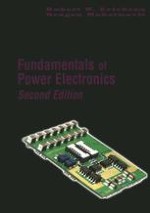2001 | OriginalPaper | Chapter
Principles of Steady-State Converter Analysis
Authors : Robert W. Erickson, Dragan Maksimović
Published in: Fundamentals of Power Electronics
Publisher: Springer US
Included in: Professional Book Archive
Activate our intelligent search to find suitable subject content or patents.
Select sections of text to find matching patents with Artificial Intelligence. powered by
Select sections of text to find additional relevant content using AI-assisted search. powered by
In the previous chapter, the buck converter was introduced as a means of reducing the dc voltage, using only nondissipative switches, inductors, and capacitors. The switch produces a rectangular waveform v s (t) as illustrated in Fig. 2.1. The voltage v s (t) is equal to the dc input voltage V g when the switch is in position 1, and is equal to zero when the switch is in position 2. In practice, the switch is realized using power semiconductor devices, such as transistors and diodes, which are controlled to turn on and off as required to perform the function of the ideal switch. The switching frequency f s , equal to the inverse of the switching period T s , generally lies in the range of 1 kHz to 1 MHz, depending on the switching speed of the semiconductor devices. The duty ratio D is the fraction of time that the switch spends in position 1, and is a number between zero and one. The complement of the duty ratio, D’, is defined as (1 – D).
